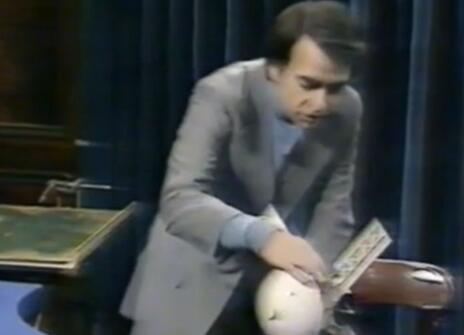Lecture 6 - Planetary systems beyond our sun
Theoretical work on the origin of solar systems suggests that planets are a frequent, if not invariable, accompaniment of stars. If there are billions of planets, if the origin of life occurs readily under general cosmic conditions, and if there are many worlds much older than the Earth for evolution to work upon, why shouldn’t the galaxy be brimming over with life?
At the time Carl Sagan delivered his CHRISTMAS LECTURES in 1977, the only known planets were the ones in our own solar system. There was no evidence to suggest planets existed outside our solar system, or that there was a star other than our own sun producing planets. This was to change just over a decade later when the first evidence of planets orbiting a star was detected by radio astronomers in 1991.
In the last of his six CHRISTMAS LECTURES, Carl Sagan explores the concept of solar systems outside our own, and asks if this were the case, how similar they might be to ours. With more than 450 extra-solar planets discovered in the past twenty years, Carl's final lecture serves as a reminder of how far we’ve come in our understanding of what exists beyond Earth.
About the 1977 CHRISTMAS LECTURES
What exists beyond Earth? Over six Lectures presented in 1977, American astronomer and cosmologist Carl Sagan explores the vast expanse of space that surrounds the third planet from the Sun.
Life on Earth
Where at first we could only discern the size of our planet and some knowledge of its atmosphere and configuration, the evolution of planetary exploration has revealed not only intricate details of Earth’s climate and geology, but a multitude of stars and planets besides our own.
Beginning with a closer look at the world we inhabit, Carl explores of the diversity of life on our own planet and the building blocks behind it, before questioning whether the same organic chemistry is occurring on planets in the outer solar system.
The Red Planet
In Lecture three onwards, Carl takes a closer look at our neighbouring planet, Mars. From early interpretations of terrestrial life on its surface to the surprising discoveries made by NASA’s Viking Program, the Red Planet has become the focus of efforts to discern whether intelligent life exists elsewhere in the universe.
When Carl delivered his Lectures in the late 1970s, NASA had only just begun its Voyager program to the furthest planets in our solar system and no extra-solar planets were known to exist. Now, over three decades later, astronomers are looking at planets that lie beyond our solar system to ask the very same question we pondered over Mars: is there life out there?





